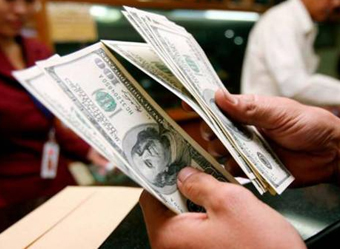The dollar’s index against a basket of six major currencies last stood at 91.919, just above lows of 91.751 set on Jan. 2.
U.S. nonfarm payrolls increased by 148,000 jobs last month, after a surge of 252,000 in November, data released on Friday showed. Economists polled by Reuters had forecast payrolls rising 190,000 in December.
On Friday, the dollar initially slipped after the smaller-than-forecast rise in payrolls, but later regained some of its composure.
“The recent trend of dollar-selling is taking a bit of a pause,” said Satoshi Okagawa, senior global markets analyst for Sumitomo Mitsui Banking Corporation in Singapore, adding that the dollar drew some support after U.S. Treasury yields nudged higher on Friday.
The U.S. currency has begun 2018 on the defensive, after the dollar index fell about 9.9 percent in 2017, its weakest performance since 2003.
A synchronized global recovery has prompted other countries’ central banks to start moving towards tighter monetary policy in recent months, helping bolster their currencies.
After the U.S. jobs data, traders of U.S. short-term interest rate futures continued to bet the Fed would raise interest rates two times this year, including a probable rate hike in March.
Comments by some Fed officials on Friday and over the weekend suggested the U.S. central bank remained on track to raise interest rates further in 2018. San Francisco Fed President John Williams told Reuters in an interview on Saturday that the Fed should raise interest rates three times this year given the already strong economy will get a boost from tax cuts, and can tighten more or less aggressively if needed.
Federal Reserve Bank of Cleveland President Loretta Mester told Reuters in an interview on Friday she expects roughly four interest rate hikes this year, as U.S. economic growth picks up and unemployment remains low.
Against the yen, the dollar firmed 0.1 percent to 113.12 yen, having traded in a range of roughly 112.00 yen to 113.75 yen over the past month.
The euro edged up 0.1 percent to $1.2045. Having started the year on a firm footing, the common currency rose to $1.2089 on Thursday, nearing a 2-1/2 year peak of $1.2092 set in early September.
The Canadian dollar last traded at C$1.2385 per U.S. dollar, up 0.2 percent from late U.S. trade on Friday.
The loonie had jumped to a three-month high of C$1.2355 on Friday, as market expectations for Canada’s central bank to raise interest rates in January surged as Canadian jobs data blew past market expectations. Source: Reuters
Source: Reuters



